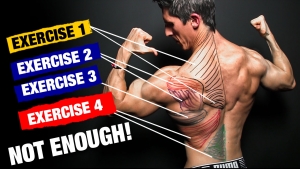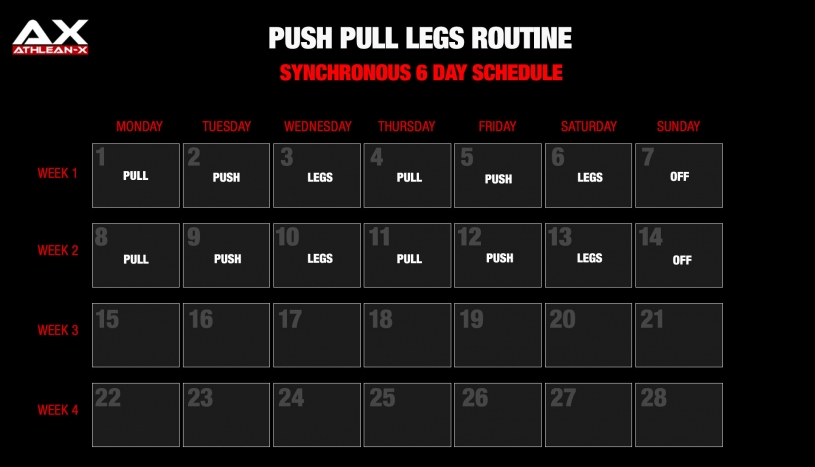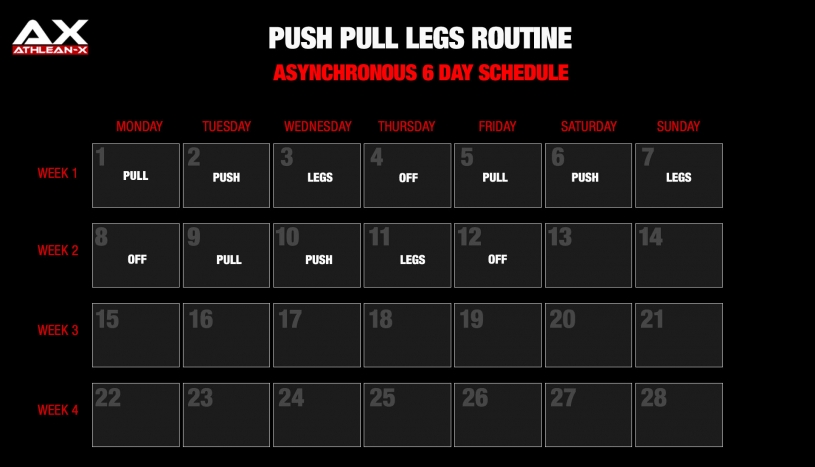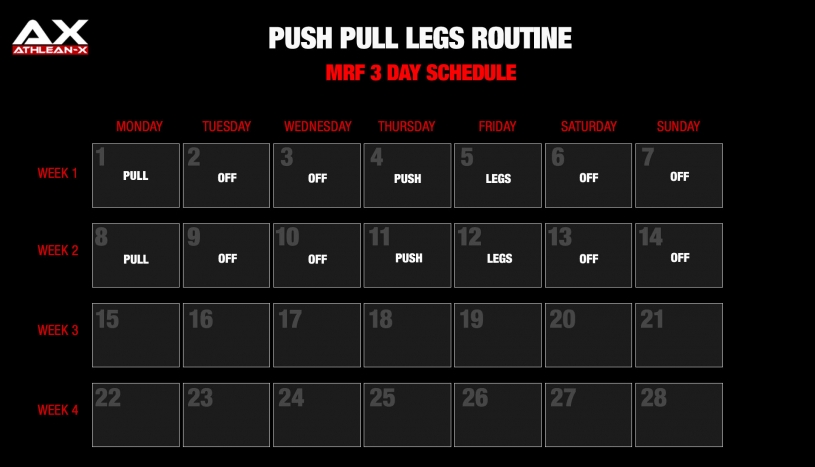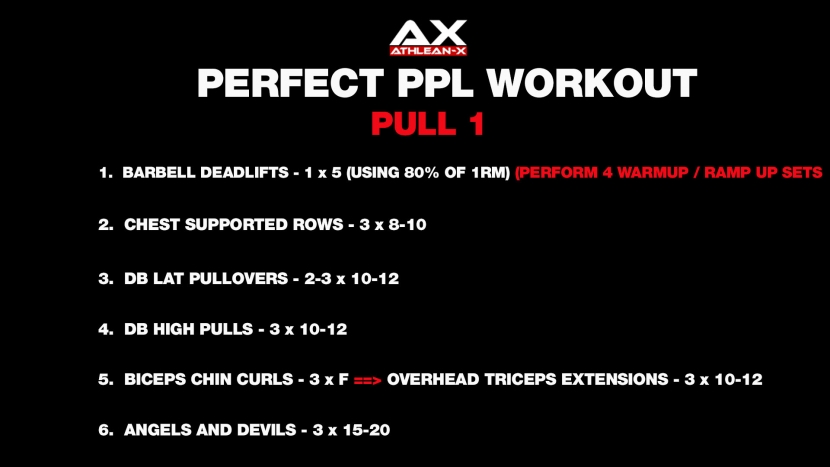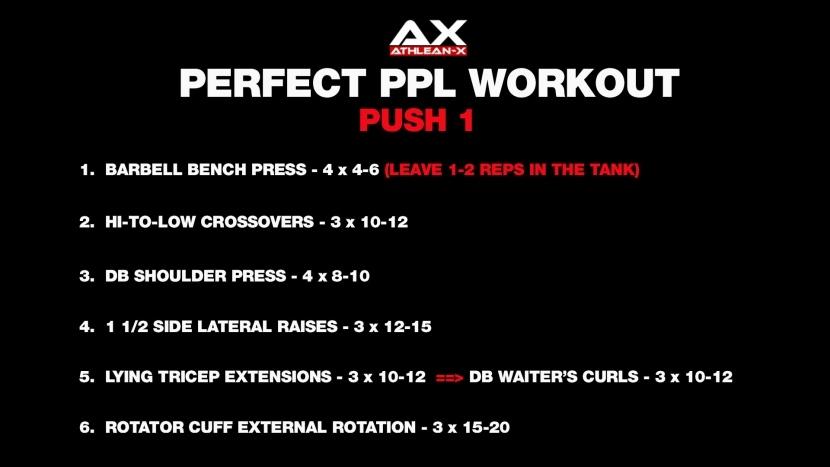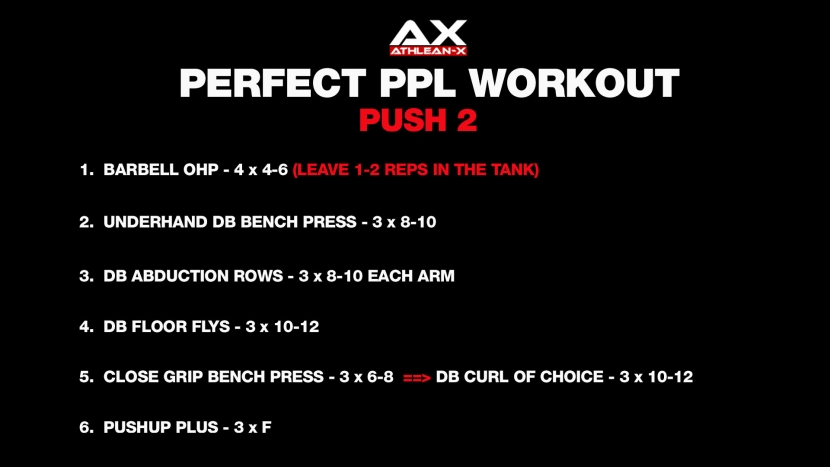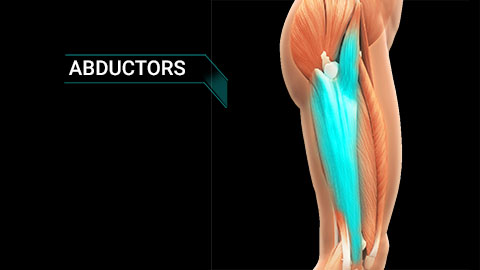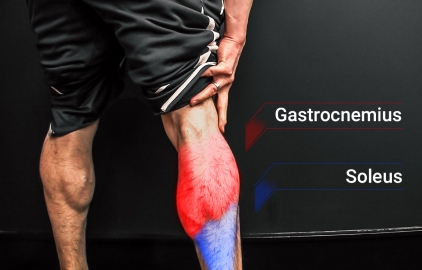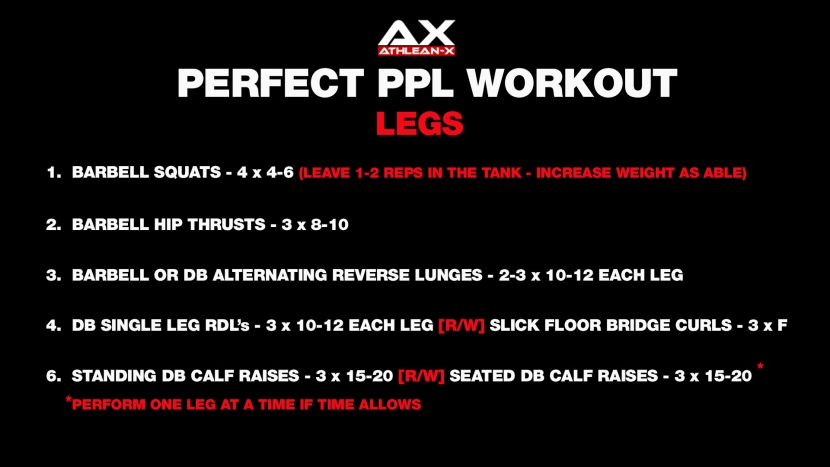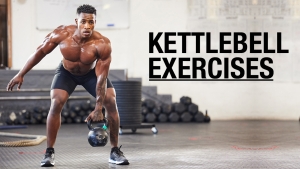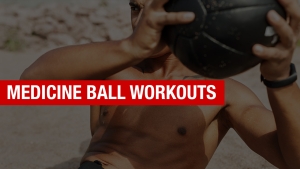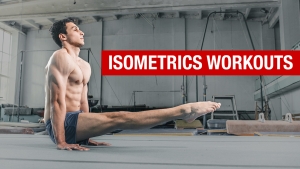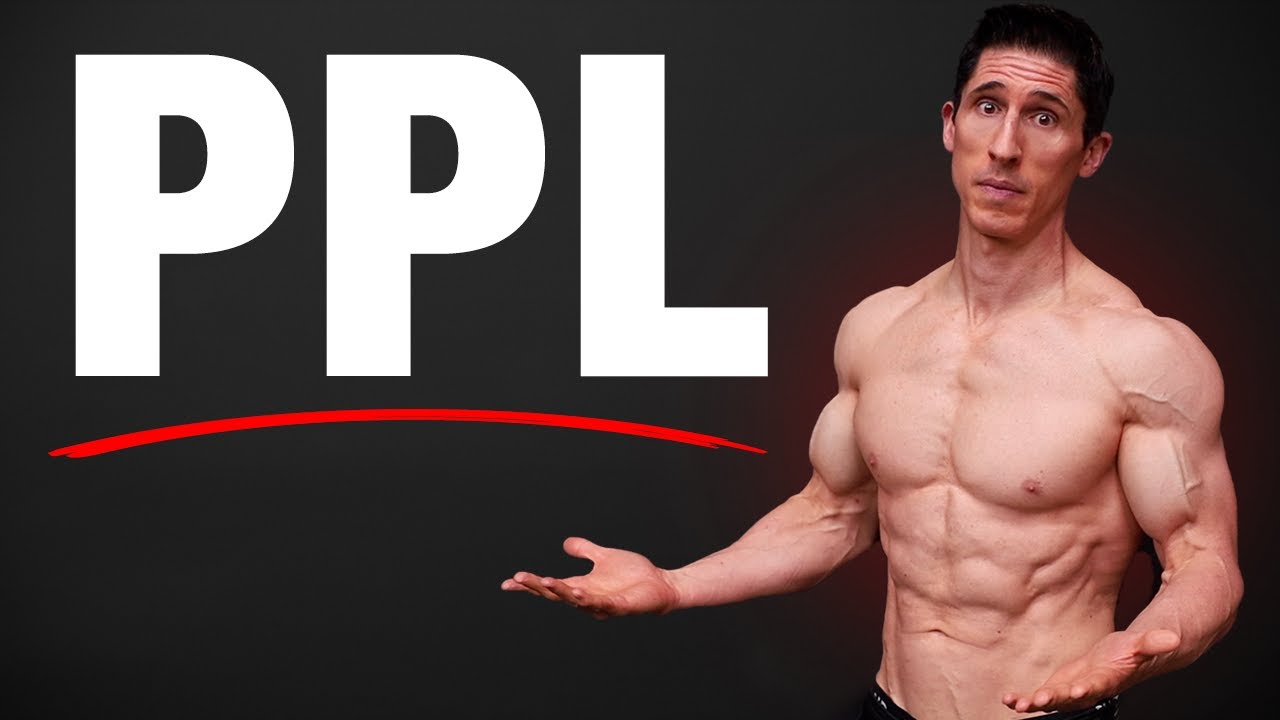
PUSH PULL LEGS ROUTINE
Guys, if you’re looking for the perfect workout for building muscle, I’d argue that you don’t need to look any further than a properly designed Push Pull Legs routine.
There’s no more popular split these days than the PPL split, and with good reason: it’s one of the most effective training splits! That’s the reason it’s been around a while.
Now, I could just focus on all the good things about this type of split, but I’m not going to do that. Instead, I want to talk about some of the things that may not be so ideal with a Push Pull Legs routine.
That way, you can make a more informed decision about whether a PPL split is for you.
If it IS a workout for mass you want to try, you’re in luck, because I’m going to cover my ENTIRE Push Pull Legs training program.
You’ll know EXACTLY what to do and on which days of your workout schedule. Let’s jump into it!
BRO SPLIT VS. PPL SPLIT
Before we delve into the pros and cons of a PPL split, I want to address another commonly asked question:
What is the difference between a Bro Split vs. PPL split?
When we’re talking about PPL versus a Bro Split or an isolation-based workout approach, it all comes down to functional efficiency. In other words, which workout is functionally efficient and which one isn’t?
When we look at a PPL split, we’re talking about shared major movement patterns, allowing muscles to work together that prefer to work together.
The opposite would be a Bro Split, one of the most common training splits, which isolates muscles with the purpose of creating hypertrophy through focus and efficiency.
For example, during a Bro Split, if I’m doing a standard dumbbell curl, I’m trying to keep the forearms out of the movement. And I would do this by bending the wrist slightly backwards to allow the biceps to do more of the work.
During a PPL, we know that the function of bringing the arm up and closer is something the biceps and forearms share. So, it’s encouraged to involve all muscle groups that share functionality.
In a PPL workout, we’re allowing our body to work muscle groups together that prefer to work together, and that efficiency can give some great results. This gives us a balanced strength routine with a balance of compound movements and accessory movements.
PROS OF A PUSH PULL LEGS ROUTINE
Let’s start with the advantages of the different training phases for the push, pull, legs basic movement patterns.
And it all starts with how flexible the training plan is. Let’s look at the different types of PPL Split and the flexibility they provide.
TYPES OF PPL SPLITS
When we talk about how we would split this common training method out over a training week, we have four primary options for training frequency.
First, we have a six-day training split where you train for six consecutive days and take an off day at the end. This is known as a synchronous split.
Or we train for three days in a row with an off day in the middle and then three consecutive days again, which is an asynchronous split.
We have three-day options as well. Our third option is to train on Monday, Wednesday, Friday.
The last option, and something I like to do, is to train on Monday, Thursday, Friday with a few days in between.
Now, the big thing that should stand out to you as the first major pro of PPL is the flexibility of focus.
I could do a lot of different things with a PPL split. I can focus on building my strength or hypertrophy with either of these six-day splits.
The three-day splits are great too. They introduce some variability because on the off days, in between my major strength training workouts, I can work on other things like my general fitness levels and my conditioning.
With a three-day split, I can do that without really affecting my strength training workouts. If you’re an athlete, you’re able to work on some skill work or speed, agility and quickness training in between the PPL days.
No matter what you choose, a PPL program offers a ton of flexibility based on your ultimate goals.
PREDICTABLE (SYNCHRONOUS SPLIT)
With a synchronous split, you know when you’ll have a day off. It’s always at the end of the week.
This gives you a predictability of scheduling. And this is important because a lot of us that run into trouble with our training splits do so because of lack of predictability.
This is a great option for people whose training schedule will need to be dictated by family needs or by your work schedule. This predictability means that you can actually hit your workouts every time they are supposed to be done.
If you’re on a clockwork schedule, the synchronous split is the best option for you.
RECOVERY TIME
One of the biggest cons that people point to is that they don’t think this is a good split for maximizing recovery times, and I tend to disagree. With an asynchronous split and the three-day splits, you’ll have plenty of rest time.
Even with a 6-day synchronous split, you have two days in between each workout type that you’re not working the same major muscles, so the muscles you worked on your pull day have time to rest while you’re working push and legs.
So, no matter which version of the PPL workout you choose, you’ll always have a little bit of additional recovery in between sessions.
EASY TO MODIFY
That being said, even if you still had some issues with a workout on a certain week, you’re able to easily modify it.
Let’s take an example of a push workout, and say you want to build your triceps more than what’s in the program. You can do some additional triceps-focused work at the end, which is an option that a lot of people choose to do.
Continuing with this example, let’s say that you added in extra triceps work on the first upper body push day workout and you were sore by the time the next push workout rolled around.
You might be worried about your recovery, and thankfully, there are a few things you could do to solve this.
Number one, you can shift or swap out the triceps exercise for that day. Instead, you can opt for a corrective exercise, and the thing I would recommend is a Face Pull. I like doing pulling-based corrective exercises on pushing days because we get so much of that pushing focus that it helps to counterbalance that.
If instead you wanted to do something different than the triceps, you could do another chest-focused exercise or even a shoulder-focused exercise.
Again, as you can see, there are many options for a PPL split, making it flexible and easy to modify.
ALLOWS FOR CARDIO AND CONDITIONING
I talked about this above, but I want to really address it here. On the three-day splits, you can easily schedule in additional exercises to increase your overall fitness level outside of your common goals of muscle growth, building strength, or fat loss.
The most common (and easiest) thing you can introduce is cardio workouts and conditioning. I’m talking about overall conditioning that’s meant to increase your heart rate and improve your endurance.
I don’t want you adding something extreme that will negatively impact your Push Pull Legs workouts. For example, if you had a leg day and you were doing conditioning work the day before and after, you’d want that conditioning work to not be eccentrically loaded.
You would want exercises that aren’t going to overtax you, so you could choose alternative exercises like the Jump Rope and Sled Pushing. These are fundamental movements that won’t leave you sore for the next day.
As a matter of fact, a major benefit of cardio and conditioning in between PPL workouts is that you’ll recover faster.
COMPLEMENTS SAQ AND ATHLETIC TRAINING
I mentioned that when we’re trying to train athletes, particularly as they approach their season, you still have to leave room for their skill work.
We need to have opportunities for athletes to work on speed, agility, and quickness or SAQ training.
A Push Pull Legs workout offers plenty of flexibility and you can intersperse your Push Pull Leg workouts with athletic training that complements the PPL days and the rest days.
CONS OF A PUSH PULL LEGS ROUTINE
Now, let’s jump into the potential downsides of a PPL split.
The good news is that I’ll also tell you how to you can adapt your plan to get around these issues.
PULL AND LEGS ARE CONFLICTING WORKOUTS (SYNCHRONOUS SPLIT)
So, we talk about a Push Pull Legs routine, but really that’s where my first issue comes in.
What I like to do is flip those around, so we have Pull Push Legs.
There’s a very important reason why I want to do that, and it has everything to do with ensuring that you don’t wind up overworking certain muscle groups.
It’s the adjacency of those two that bothers me, so I want to take it and split this to a different order: PULL, push, then LEGS. I’ve split up these two workouts so that I’m not Deadlifting and Squatting back-to-back.
It’s one of the important things I think we should really try to do.
That being said, you will see that these two will run up against each other the second time around. That’s where it could have an impact on recovery in a six-day split, even if you were to set it up as Pull Push Legs.
But here’s the thing: You don’t have to do the same pull workout every time it comes up.
In the routine I’m going to provide you, we have two variations of the Pull Workout. Yes, you’ll be doing Barbell Deadlifts in the first Pull Workout, but in the second Pull Workout, you’ll perform a deadlift variation that’s not going to be as loaded, heavy, or problematic for the squats that will precede it.
Something else you can do is change the loading parameter. So, instead of doing one set of five reps, you can do three sets of five reps with a lighter weight. The light weights help you decrease the strain and stress on the muscles that are worked by these exercises.
Even better, you don’t even have to change the loading parameter with the deadlifts if you don’t want to. You can simply shift your focus to the Weighted Pullup as an alternative heavy pull exercise, and you’ll just need to increase the volume a little bit, if need be.
Again, there’s plenty of flexibility within the workouts. You don’t always have to do the same workout.
As a matter of fact, I highly encourage you change it up to something that is ideal for you, your goals, and your schedule.
UNPREDICTABLE (ASYNCHRONOUS SPLIT)
The next potential disadvantage of a PPL workout is the unpredictability of an asynchronous split. Since the complete rest day is always moving, this could be a little challenging for those people that have a very fixed schedule.
Although I highly recommend the asynchronous split for most people because of the added recovery time, you might run into trouble if you’re schedule is set in stone.
Instead of this version, you can do a synchronous split or one of the three-day options.
ONLY THREE DAYS PER WEEK?
I’ve heard people complain that the Push, Pull, Legs workout is only three workouts per week. Now, while you can make this a 3 day split, you also have the popular option for a 6 day split.
These same people will claim that you’re doing two days of upper body muscles and only one day of lower. When you look at the focus of those days, you actually aren’t doing that either.
You’re focusing on agonistic muscles that like to pull and agonistic muscles that like to push and then legs. So, you have three major focuses that each get done two times a week.
Plus, when we consider the fact that we’re actually deadlifting on pull day, I think that really counters that argument, too.
TOUGH TO INCORPORATE INTENSITY TECHNIQUES
The next thing people will talk about is that it’s difficult to incorporate intensity techniques when you’re doing Push Pull Legs. I don’t see that. As a matter of fact, I think you could easily incorporate intensity techniques if you wanted to.
For example, you could do eccentrically focused exercises during your pull day workout such as slow eccentrics on both a Pull-Up and Lat Pulldown. Best of all, this wouldn’t impact your performance during the next Pull Day because you have plenty of time for recovery.
Let’s compare that to a total body split, which would make it far more difficult to add intensity movements.
That’s the case because you’re working all major muscle groups three times per week – usually Monday, Wednesday, and Friday. Since all major muscle groups are involved, anything that I do on Day One can potentially impact how I perform on Day Two or Three.
WORKOUT LENGTH IS TOO LONG
The final con that people will mention about a Push, Pull, Leg routine is that they take too long to do. Guys, a typical PPL split shouldn’t take you any more than about 60 minutes. But I’ll play devil’s advocate here.
Using the example above, if you have to address your weak points with accessory movements (e.g., triceps), it’s just going to increase your workout length.
Okay, fair point.
But I’ll say this: How much are you really impacting that workout length by adding one more exercise to the end of the workout? And in this case, it’s a triceps exercise, which doesn’t require nearly the effort as say a bench press would.
IS A PPL SPLIT RIGHT FOR YOU?
So, taking all of this into consideration, is the Push Pull Leg training method a good split for you?
It absolutely is.
Beginner lifters, intermediate lifters, advanced lifters… it doesn’t matter! A PPL split can help everyone regardless of training experience and fitness level.
There are a lot of major benefits to these effective workout routines with a big emphasis on flexibility in when and how you perform these workouts.
A PPL split allows you to do more than just a typical strength training program. You can focus on other things like hypertrophy or athletic training.
There’s so much variability built into this.
Most importantly, there’s plenty of recovery built into whatever variation of this workout program you choose.
With that said, let’s jump into the Push Pull Legs routine that I described above.
And that means we start with a Pull workout. Let’s get to it!
PULL WORKOUT: ANATOMY OF THE PULL MUSCLES
Let’s begin by reviewing the anatomy of the major muscle groups (pull muscles) in the upper body that you’ll be targeting in the Pull Workout.
Guys, listen up! You need to create a strong mind-to-muscle connection in order to see the best results with these pull muscle groups.
With that said, here’s what you’re focusing on during the pulling exercises.
THE LATS

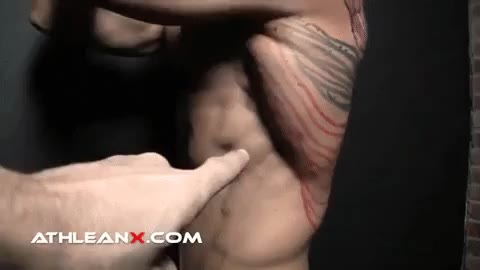
UPPER AND LOWER TRAPS


LOW BACK / ERECTOR SPINAE

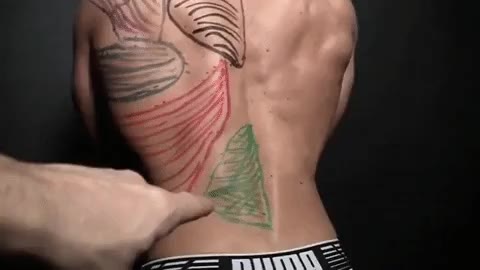
ROTATOR CUFF

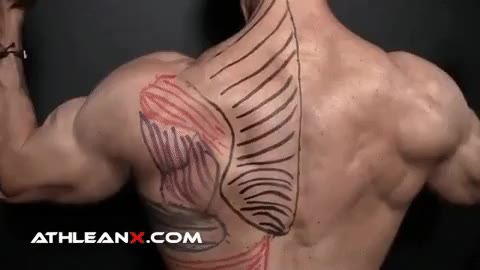
TERES MAJOR

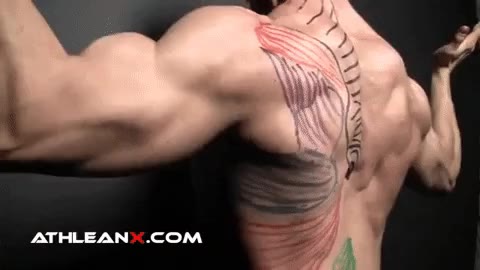
SHORT HEAD (INNER BICEPS)


LONG HEAD (OUTER BICEPS)

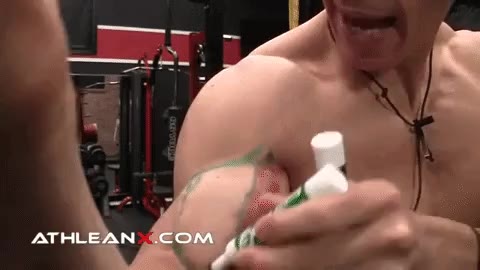
BRACHIALIS

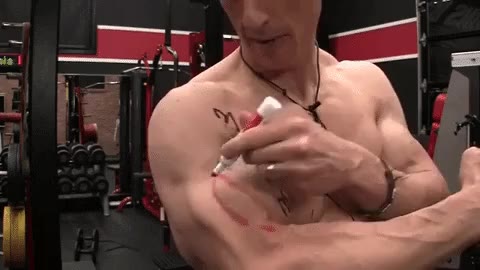
PULL WORKOUT ONE
Let’s kick off this Pull Workout with a classic muscle builder for the pulling muscles: the Conventional Deadlift.
You’ll start with four warm-up sets that eventually progress to 80% of your one-rep max for your one set of five.
DEADLIFTS


Then, perform the Deadlift for one heavier weight set of five reps.
Starting position for the deadlift is standing with feet shoulder width apart and a loaded barbell on the ground. Bending at the knees, grab and lift the barbell, straightening the knees as you come up in a controlled movement. Keep your core tight the entire time. Take 1-2 minutes of rest between sets on your compound movements.
While it’s a super effective lift, the deadlift has a lot of moving parts, so I’d consider it an exercise for advanced lifters. With that said, you can become an advanced lifter by focusing on proper form and execution.
To ensure progress, add an appropriate amount of weight to your next workout.
CHEST SUPPORTED ROW

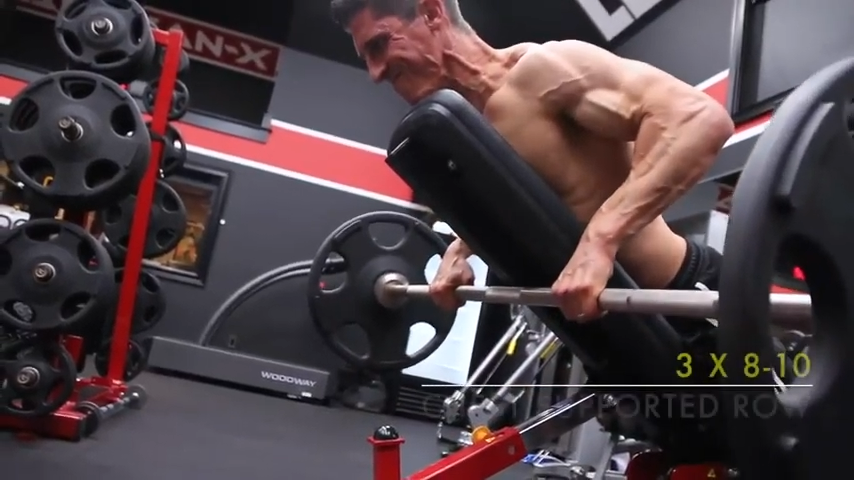
Perform three sets of 8 to 10 reps for the Chest Supported Row.
Why no traditional Bent Over Barbell Row? Yes, traditional Barbell Rows are fantastic, but I prefer this movement for a couple of reasons:
First, this stance alleviates some of the strain on the low back. Second, this lift targets the upper back muscles, which are often neglected.
DUMBBELL PULLOVER

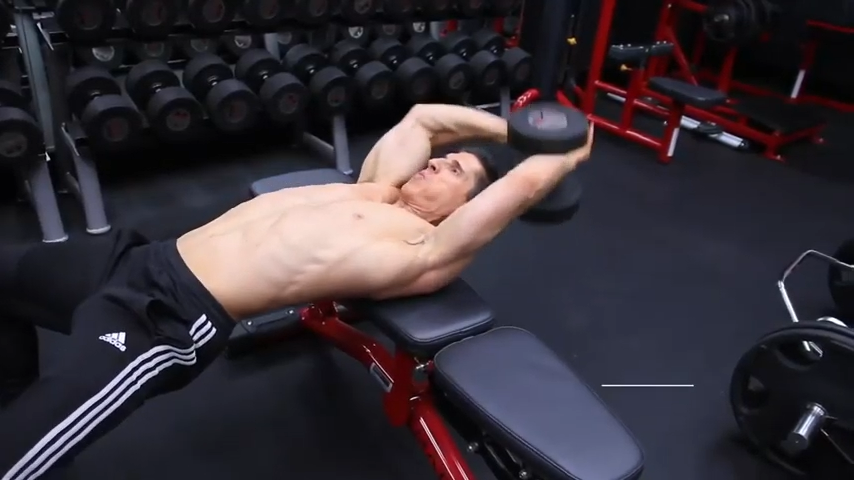
Perform the Dumbbell Pullover for two to three sets in the 10 to 12 rep range. Remember to pick a weight that allows you to fail within that rep range.
This powerful pulling exercise will give your upper back a bit of a break. Instead, it’ll focus more on the lats.
Adjust the weight accordingly. If you can do more than 12 repetitions in the next few workouts, increase the weight. But if you can’t get into that rep range because you’re using heavy weight, you need to lower the weight load.
Finally, remember that you aren’t restricted to a dumbbell. If you only have access to cables or kettlebells and a bench, that’s okay.
DUMBBELL HIGH PULL

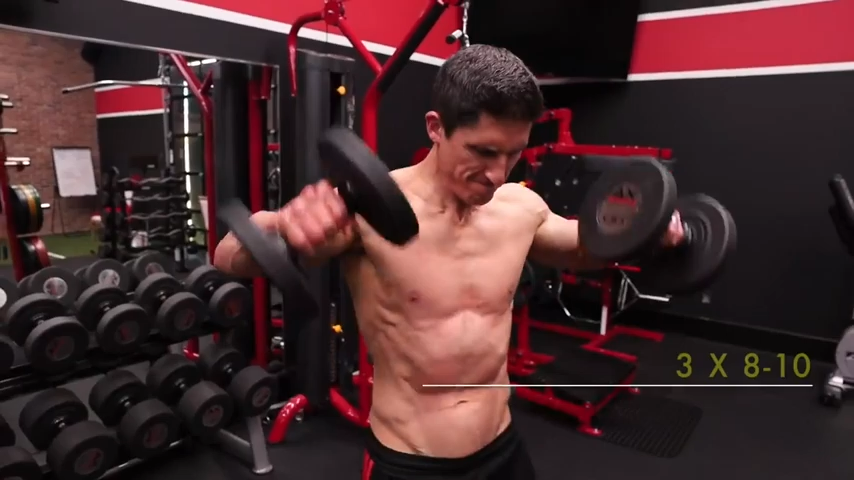
Perform three sets of 10 to 12 repetitions of the Dumbbell High Pull. This lift focuses on external rotation, not internal rotation like we would in an Upright Row.
This is a fantastic exercise for bullet-proofing the rear delts and upper traps.
BICEP CHIN CURL

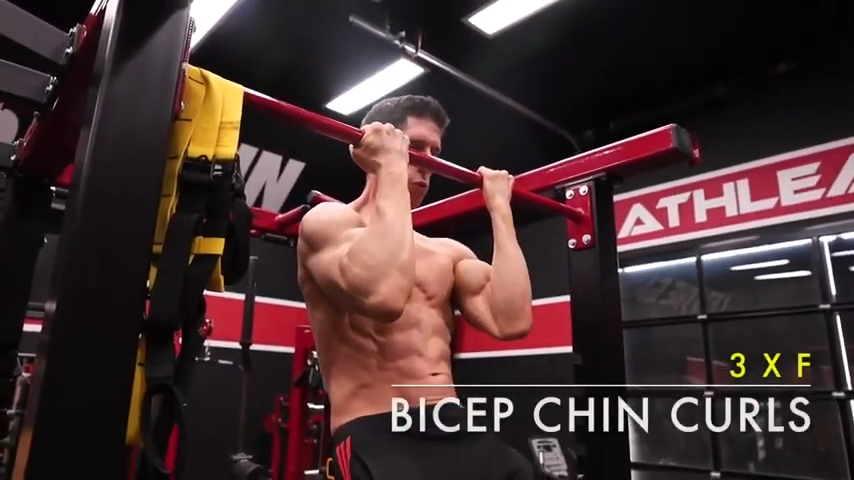
This is your first superset exercise. Perform three sets to muscle failure of the Bicep Chin Curl, and then immediately jump into the next pull exercise.
The Chin Curl focuses on closing the angle of the elbow down as you approach the top of the bar.
So, you’re mimicking the mechanics of a Barbell Curl, but make sure to keep a slight bend in the elbows. Keep your core muscles tight throughout the movement.
OVERHEAD TRICEPS EXTENSION


As mentioned above, this is a superset of the Bicep Chin Curl with a basic Overhead Triceps Extension. Perform three sets of 10 to 12 reps.
Why am I including a triceps exercise on Pull Day?
This allows you to get some additional weekly volume on the arms that oftentimes get overlooked in typical PPL splits. It also helps to counterbalance the load you’re putting on your body.
ANGEL AND DEVIL


Perform three sets of 15 to 20 reps of the Angel and Devil.
This is one of my all-time favorite movements to hit the entire back including the upper back, the mid-back, the lower back, the lower traps, the paraspinals.
PULL WORKOUT ONE – SUMMARY
PULL WORKOUT: TWO
And this brings us to your second pull workout, which will complement Pull Workout One.
You start off with Snatch Grip Deadlifts, performing three to five sets with a weight that you can handle for about eight repetitions.
SNATCH GRIP DEADLIFTS

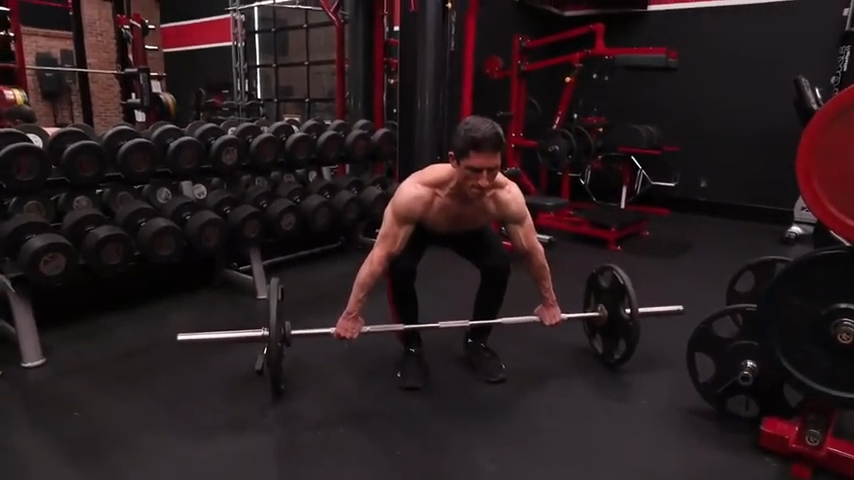
Unlike your other Pull workout, this starting exercise is not meant for progressively overloading strength movement patterns. Rather, this one focuses on reinforcing the hinge pattern.
More importantly, you’re performing this lift to allow for additional volume without the overload from a heavy weight.
Remember what I talked about above: By doing this variation of the Deadlift, you won’t have the competing factor with your Leg Day.
WEIGHTED PULLUP

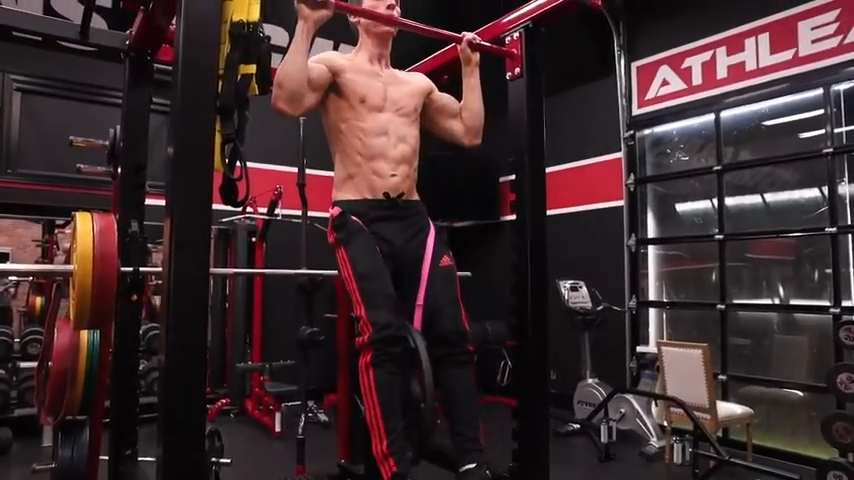
Using a pull-up bar or cable machine pull-up bar, perform three sets of six to eight reps of Weighted Pullups.
This bilateral exercise will build those lats along with your overall pulling strength. The catch is that you have to make sure that you’re loading heavy enough.
DUMBBELL GORILLA ROW

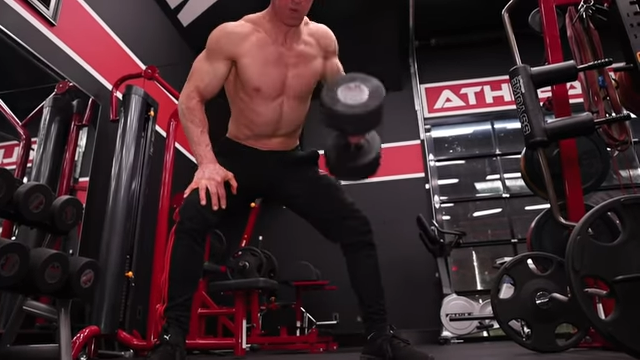
Perform three sets of 10 to 12 repetitions on each arm of the Dumbbell Gorilla Row.
The reason I prefer this over One Arm Dumbbell Rows is because having one knee up on a flat bench increases your risk of developing a hernia.
STRAIGHT ARM PUSHDOWN


Perform two to three sets of 12 to 15 repetitions of the Straight Arm Pushdown.
Since this lift focuses on improving your straight arm scapular strength, it starts to cross over into the corrective category.
BARBELL CURL


This is a superset exercise with biceps curls and a triceps pushdown. The first part of the superset is Barbell Curls.
Perform three sets of six to eight repetitions of the Barbell Bicep Curl.
TRICEPS PUSHDOWN

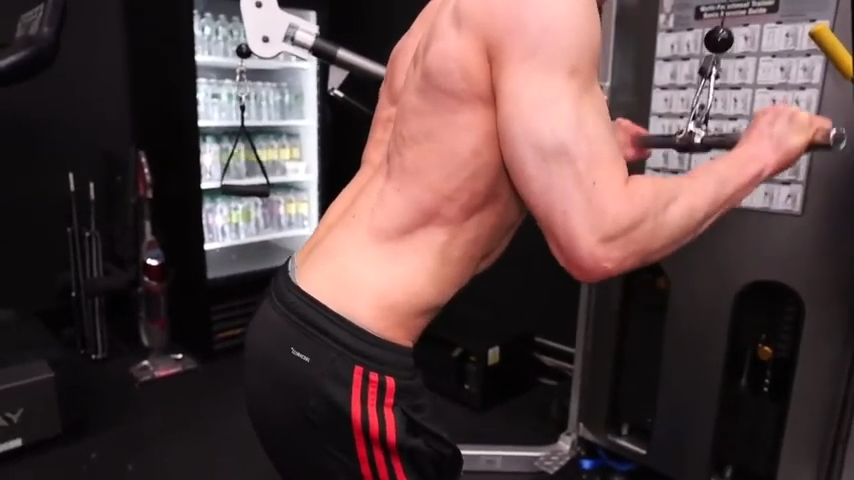
This is the second part of the superset. Perform three sets of 10 to 12 in of the Triceps Pushdown.
FACE PULL

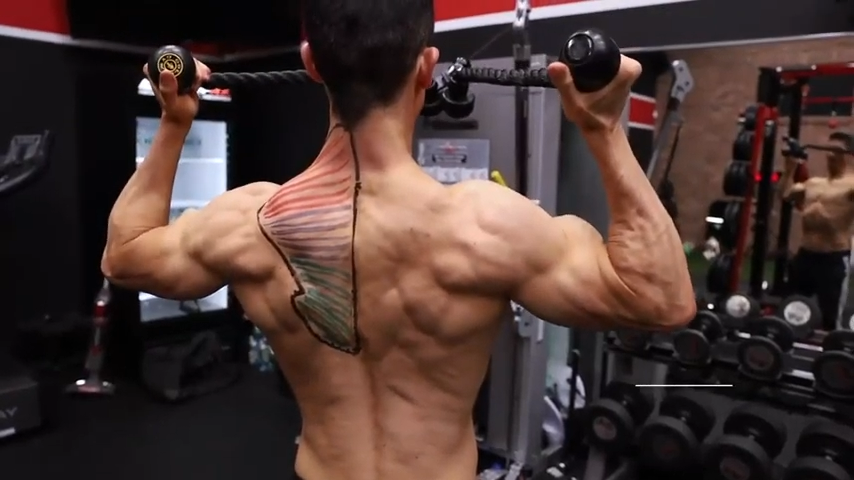
Perform three sets of 15 to 20 repetitions of the Face Pull.
This exercise targets the entire upper back, the mid-scapular area, and the rotator cuff muscles.
As always, keep a close eye on the angle of pull here. You don’t want to pull the rope downward toward the ground.
PULL WORKOUT: TWO – SUMMARY
PUSH WORKOUT: ANATOMY OF THE PUSHING MUSCLES
We’ll start by understanding the anatomy of each of the push muscles in the upper body.
There are some specific areas of the chest, shoulders, and triceps that will be targeted with heavy compound movements in this Push Workout.
Examples of pushing exercises include the bench press and body weight push-up.
UPPER CHEST


MIDDLE CHEST


LOWER CHEST


SHOULDERS: FRONT DELT


SHOULDERS: REAR DELT

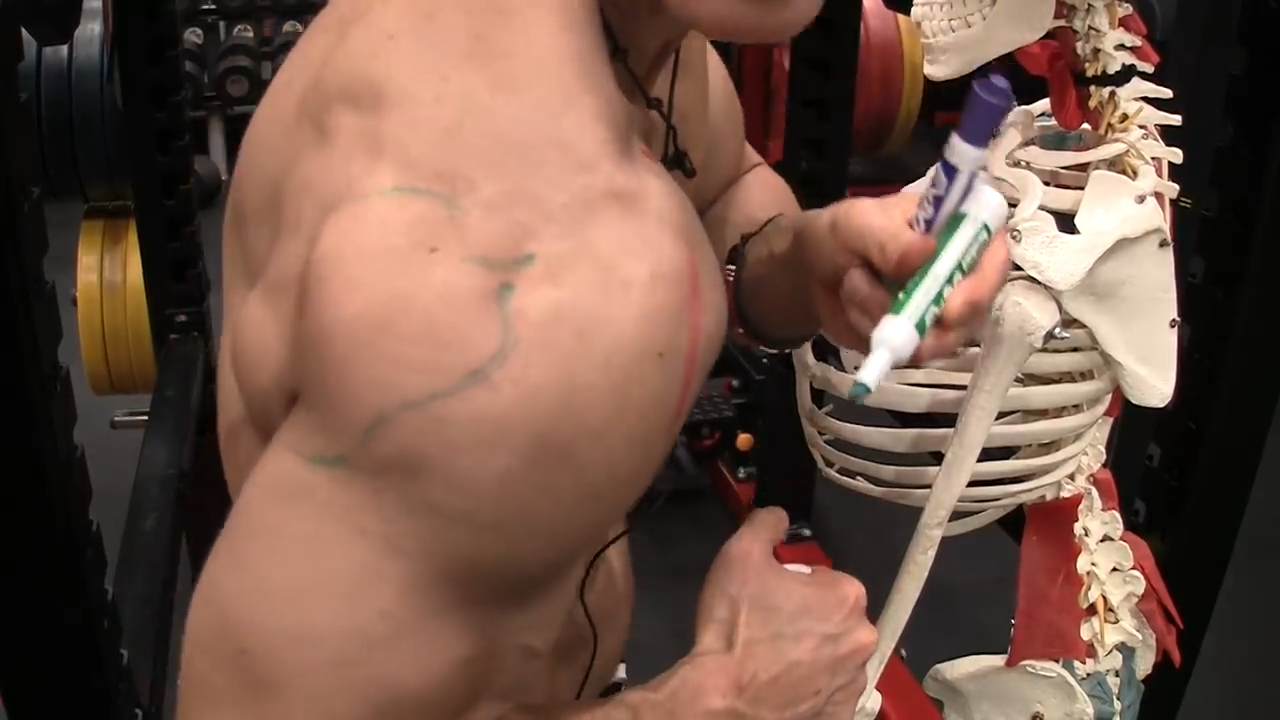
SHOULDERS: MIDDLE DELT

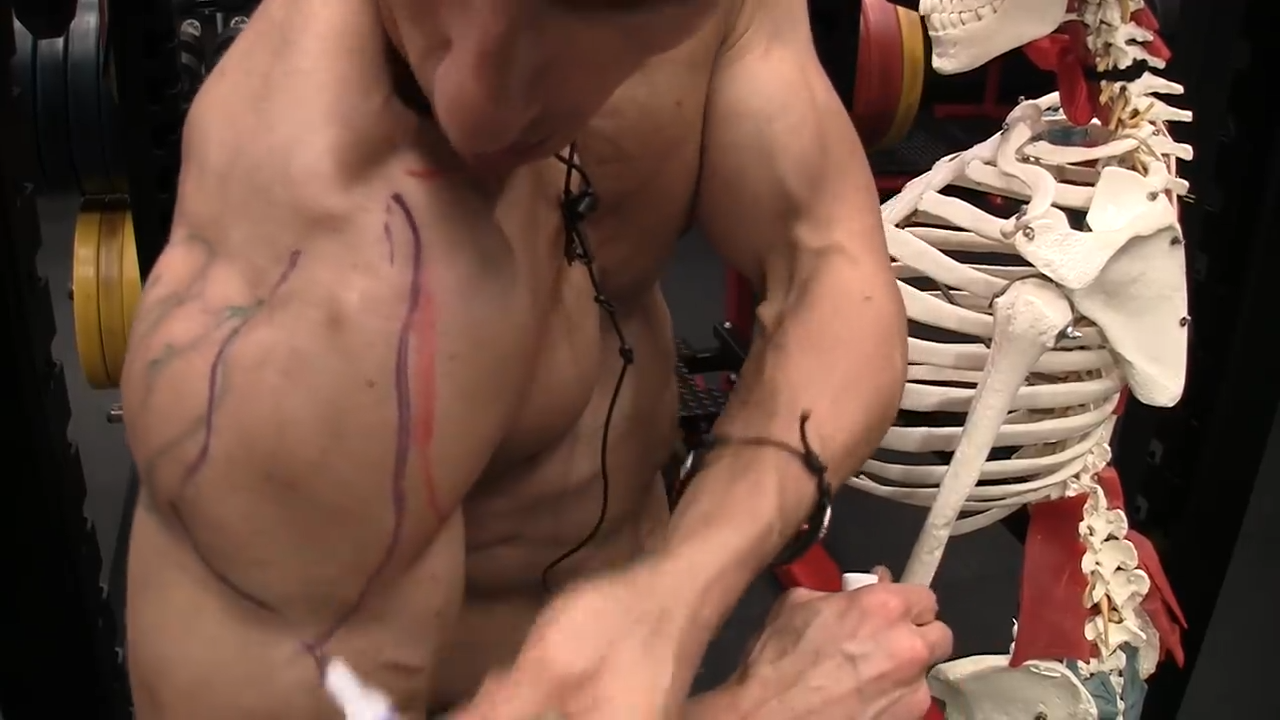
TRICEPS: LATERAL HEAD


TRICEPS: MEDIAL HEAD

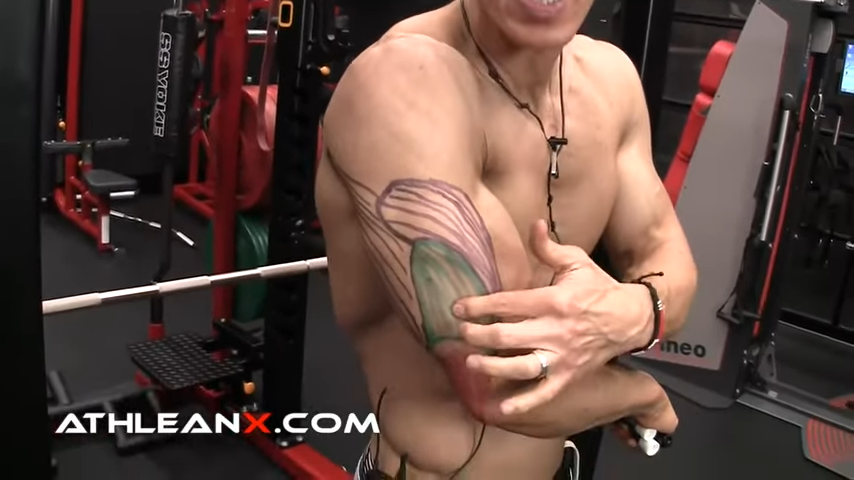
TRICEPS: LONG HEAD


PUSH WORKOUT ONE
This Push Workout begins with a standard upper body pushing exercise for the chest muscles, which is useful for developing upper body strength, muscle gains, and power.
I’m talking, of course, about the staple of chest training: the Barbell Bench Press or Barbell Flat Bench Press.
BARBELL BENCH PRESS

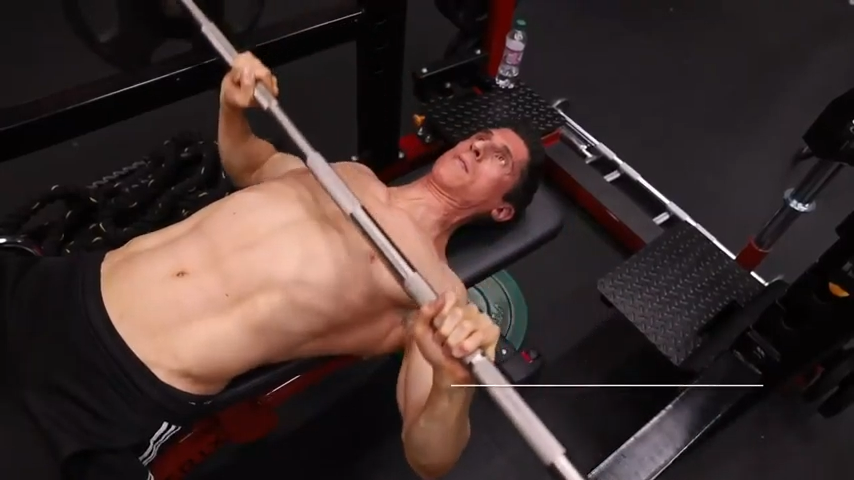
Perform this as four sets of four to six repetitions of the flat Barbell Bench Press. But don’t take your pectoral muscles all the way to failure on this one. Take 1-2 minutes of rest between sets.
There’s a couple of quick things I want to mention on this one. If you only have access to dumbbells, then you can perform the Dumbbell Bench Press.
If you want to switch this up, I’d recommend the Incline Barbell Bench Press
HI-TO-LOW CROSSOVER


Next, perform three sets of 10 to 12 reps of another chest exercise: the Hi-To-Low Crossover.
The Crossover is the perfect complement to the Bench Press because it allows the chest to get into a completely contracted position.
It does this by getting the arm into the motion of being fully adducted across the body.
DUMBBELL SHOULDER PRESS

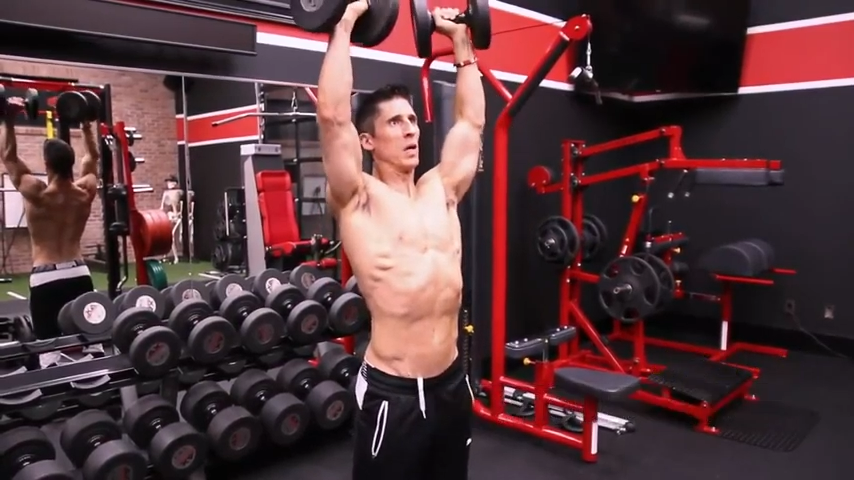
Perform four sets of 8 to 10 reps of the Dumbbell Shoulder Press.
1 1/2 SIDE LATERAL RAISE

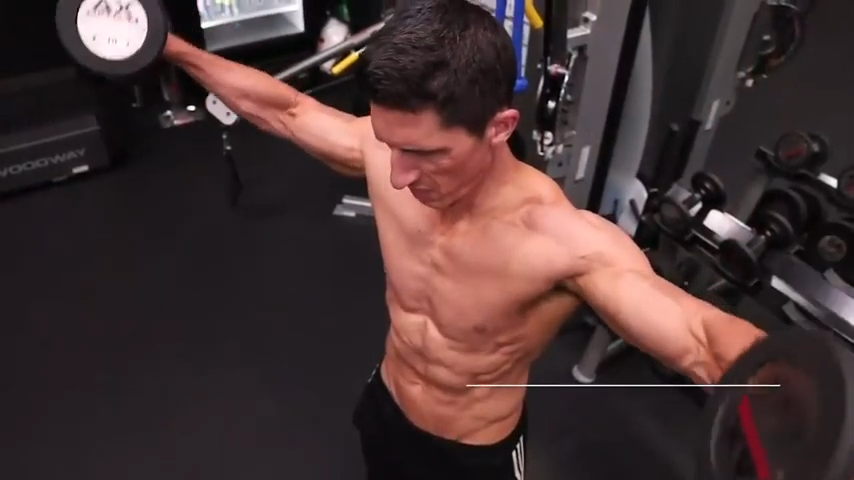
Perform three sets of 12 to 15 reps of the 1 1/2 Side Lateral Raise.
This exercise will focus on increasing the muscle size of the middle or lateral delt by increasing the time that it’s under tension.
LYING TRICEP EXTENSION

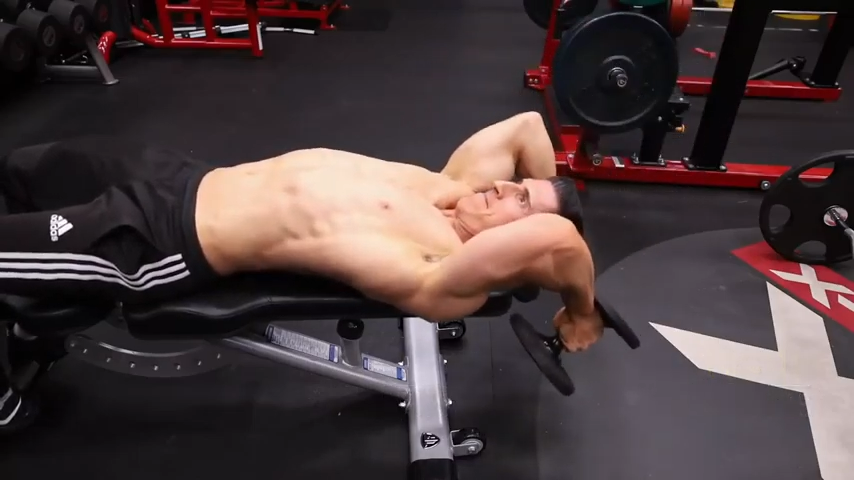
This is a superset exercise. Perform three sets of 10 to 12 to failure of the Lying Triceps Extension.
Again, this will give you a chance to get in that much needed additional volume for the arms.
DUMBBELL WAITER’S CURL

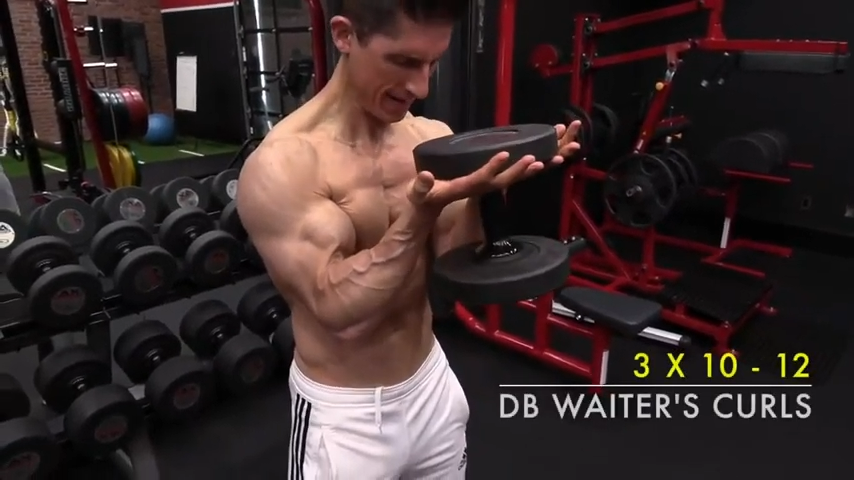
This is the other half of that superset. Perform three sets of 10 to 12 reps of the Dumbbell Waiter’s Curl.
ROTATOR CUFF MUSCLE EXTERNAL ROTATION


Finally, you’ll wrap up this workout with a corrective exercise. Perform three sets of 15 to 20 reps of the Rotator Cuff External Rotation.
The reason I include this exercise is because I want to counterbalance the amount of internal rotation you’re doing in the Push Workouts.
PUSH WORKOUT ONE – SUMMARY
PUSH WORKOUT TWO
That brings us to your next Push Workout, which is designed to complement the first push workout.
And we kick off this workout with a heavy load focus on a classic barbell exercise: the Overhead Barbell Press.
OVERHEAD BARBELL PRESS

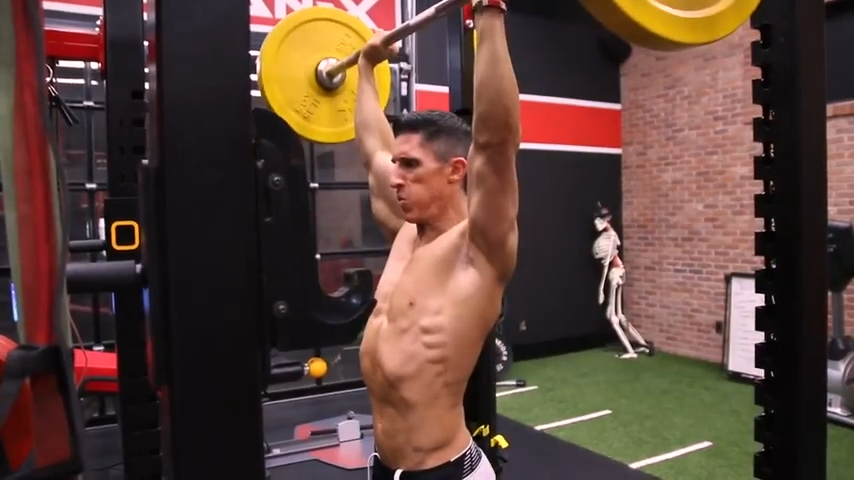
Perform four sets of four to six reps of the Overhead Press, but just like before, be sure to leave a few reps in the tank. Don’t go to complete failure during these Barbell Presses.
DUMBBELL UNDERHAND BENCH PRESS


Perform three sets of 8 to 10 reps of the Dumbbell Underhand Bench Press.
This underhand grip exercise saves your shoulder muscles and front delts from odd angles, overload, and potential injury.
ABDUCTION ROW


Perform three sets of 8 to 10 reps per arm of the Abduction Row.
DUMBBELL FLOOR FLY

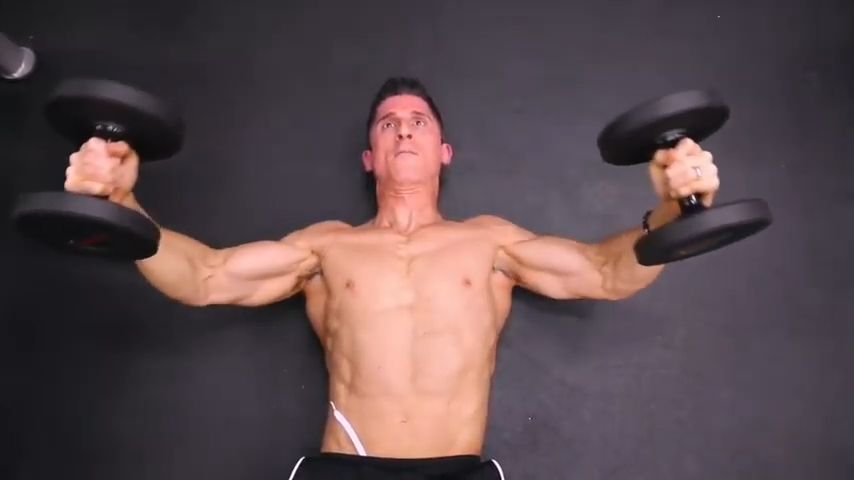
Perform three sets of 10 to 12 of the Dumbbell- Floor Fly.
There are two reasons you’re doing these on the floor. First, the floor provides a safety net to ensure you’re not over-stretching the capsule of anterior shoulder. Second, it gives you the chance to go heavier and focus on the eccentric load.
TRICEPS CLOSE GRIP BENCH PRESS

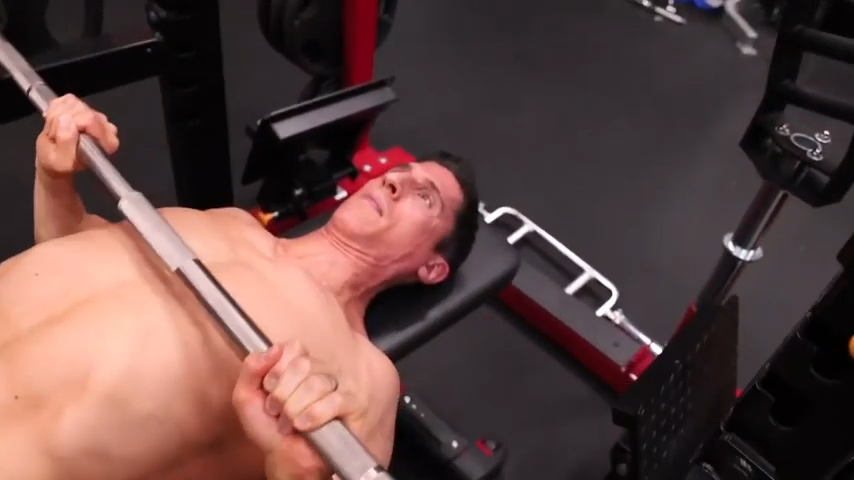
This is a superset exercise. Perform three sets of six to eight reps of the Triceps Close Grip Bench Press.
DUMBBELL CURL OF CHOICE

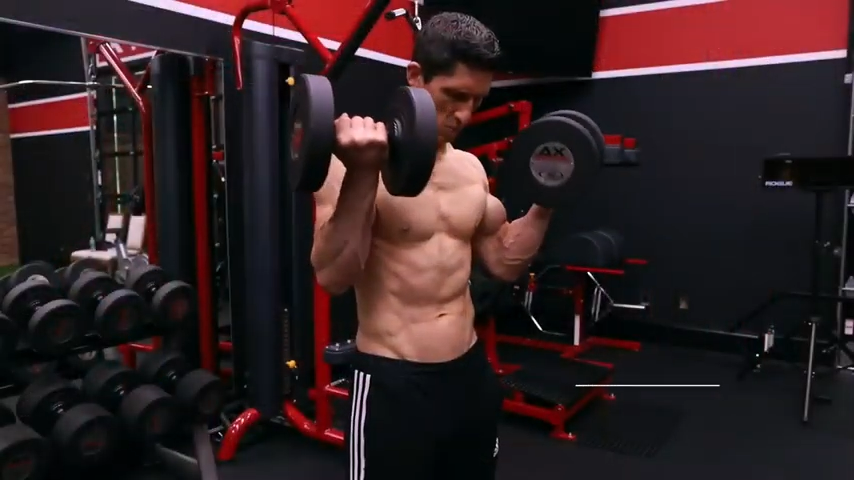
This is the other half of the superset.
Perform three sets of 10 to 12 reps of a Dumbbell Curl of your choice.
PUSHUP PLUS

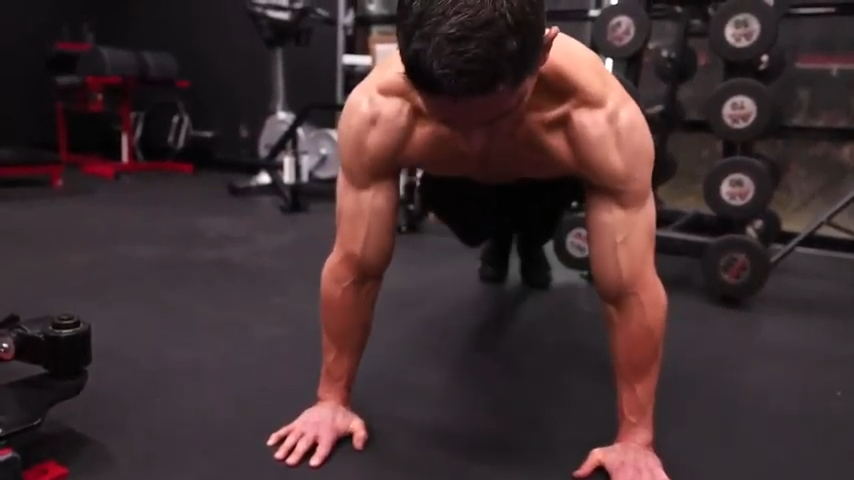
Your final exercise focuses on the serratus anterior, a part of the obliques that most people don’t pay much attention to.
Perform three sets to failure of the Pushup Plus. Focus on getting into the top of a Push Up, and then you push all the way through.
PUSH WORKOUT TWO – SUMMARY
LEG WORKOUT: ANATOMY OF THE LEG MUSCLES
Before I jump into the leg workout for this PPL split, I want to cover the leg muscles you’ll be targeting.
This will help form a strong mind-to-muscle connection, ensuring you see better results.
VASTUS MEDIALIS

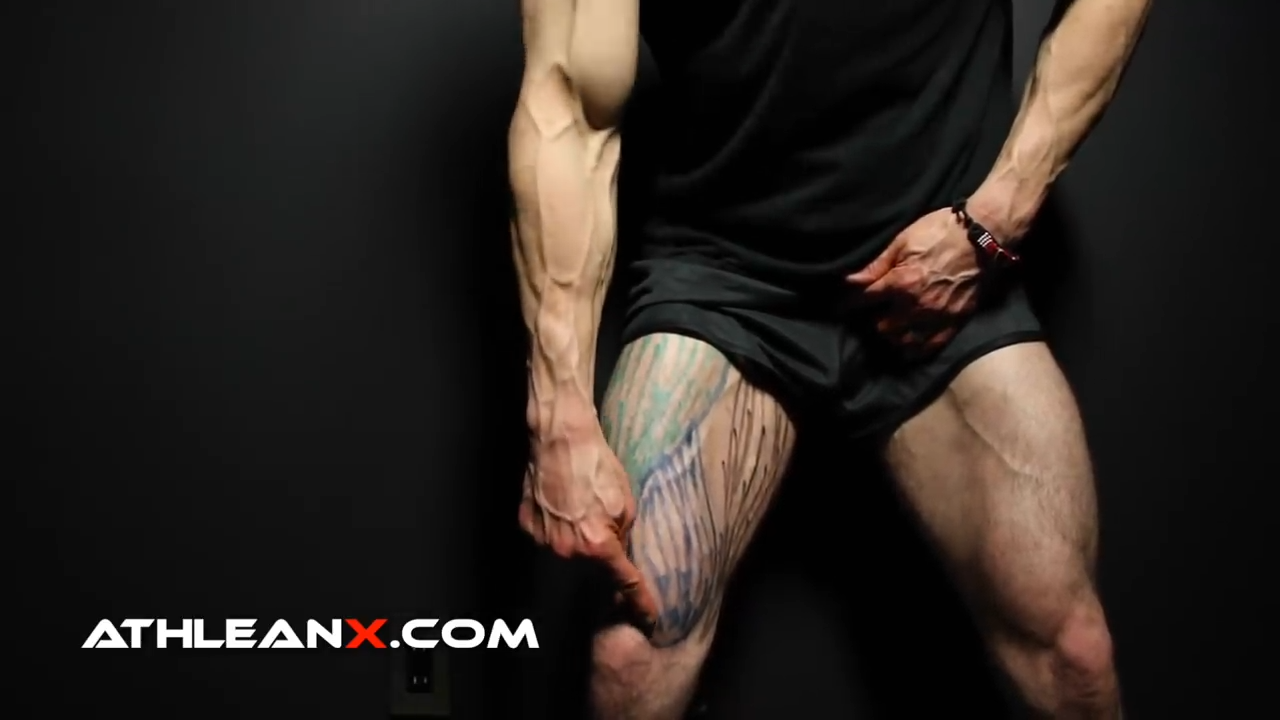
VASTUS INTERMEDIUS

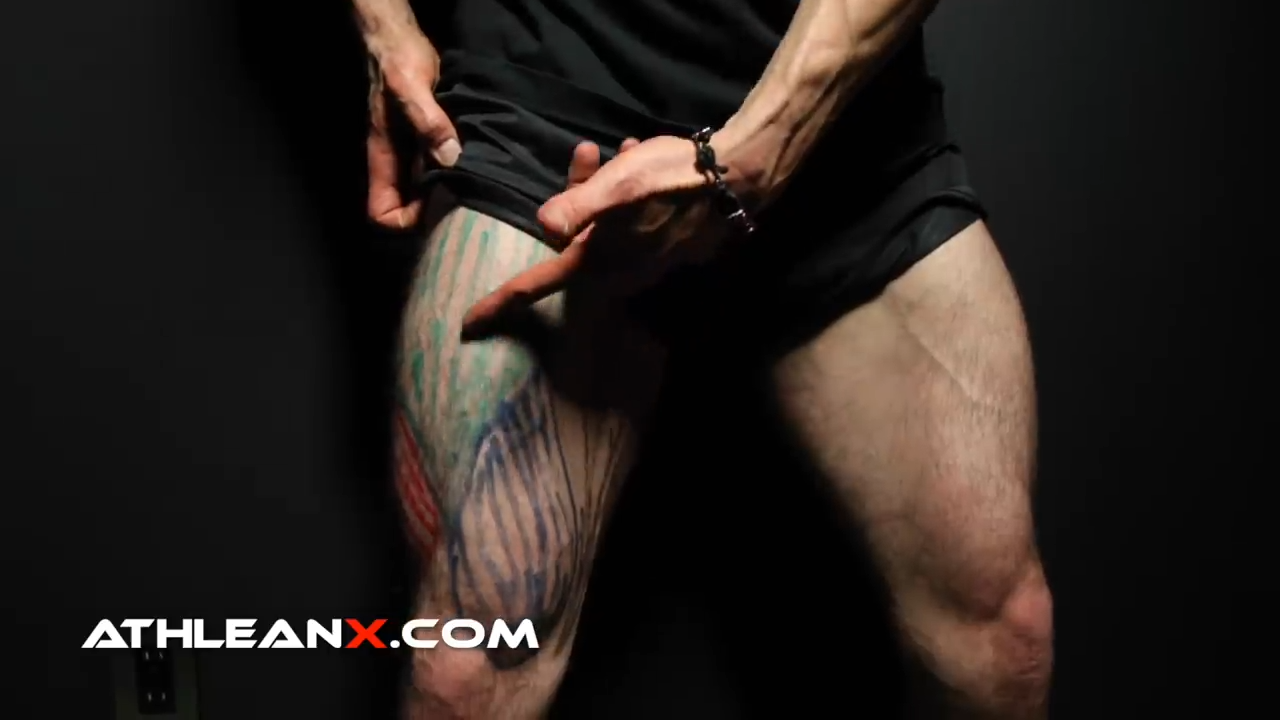
VASTUS LATERALIS

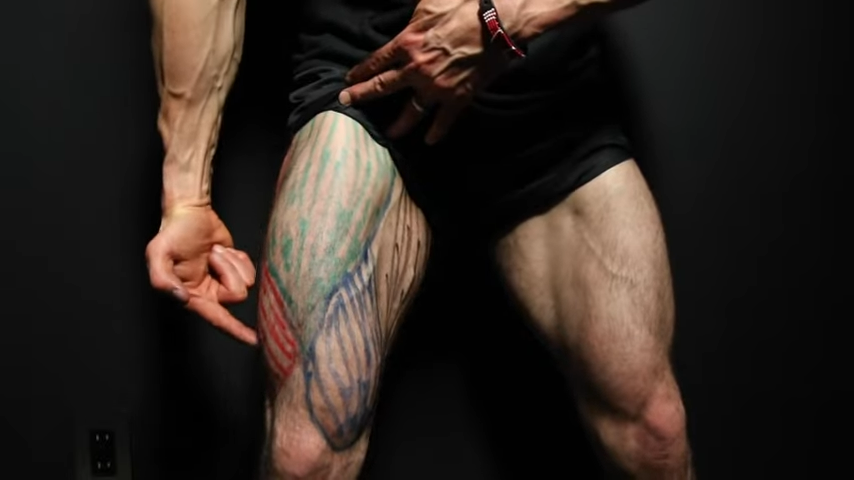
RECTUS FEMORIS


BICEPS FEMORIS

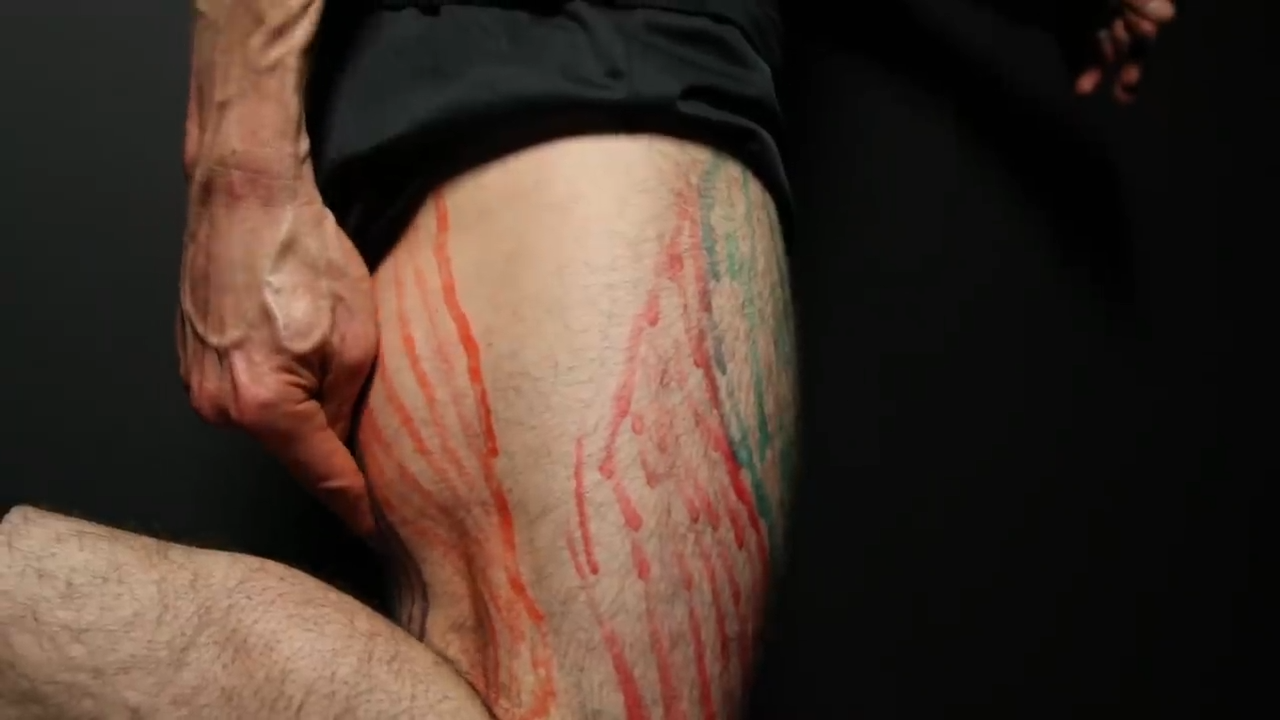
SEMITENDINOSUS

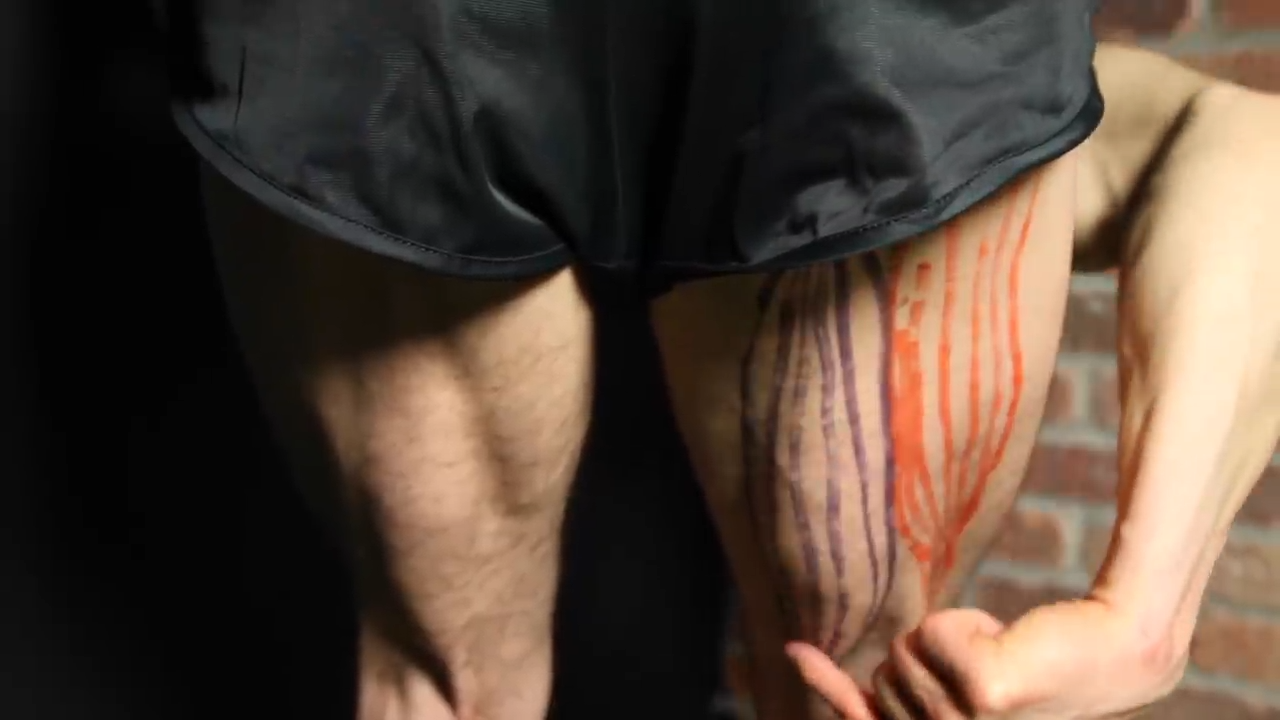
ADDUCTORS

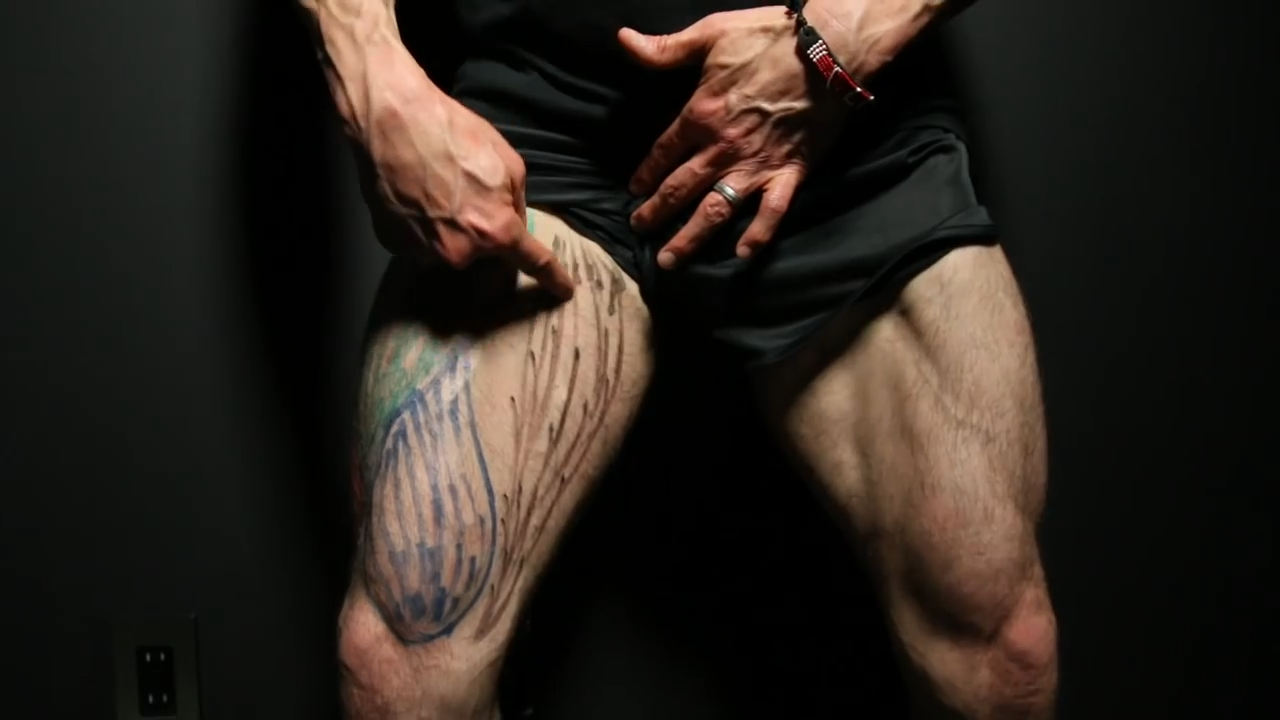
ABDUCTORS
GASTROCNEMIUS AND SOLEUS
LEG WORKOUT
You’re on the final stretch here, guys, so let’s start breaking down this workout.
We’re kicking things off pretty much exactly as you’d expect with the Barbell Squat.
BARBELL SQUAT

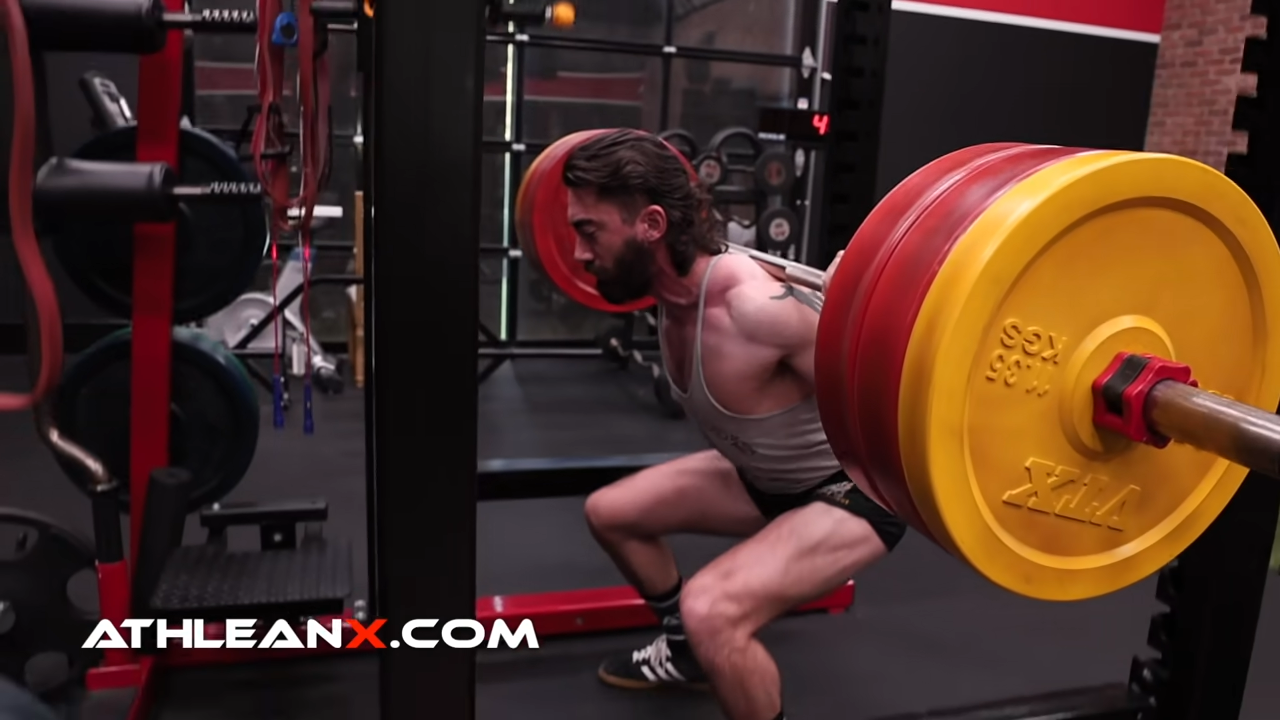
Perform this heavy compound lift as four sets of four to six reps, but as always, I want you to leave one or two reps in the tank. I still want you to focus on progressively increasing your strength in the lift by adjusting the weight to accommodate the rep range.
Let’s talk quickly about squat variations.
If you’re feeling burnt out when your next leg workout comes along, consider Bulgarian Split Squats as a switch. This is a compound lift that targets the same major muscles but doesn’t have the heavy load from the barbell across your back.
Another option would be a Leg Press, but stick to free weights, if you can.
BARBELL HIP THRUST

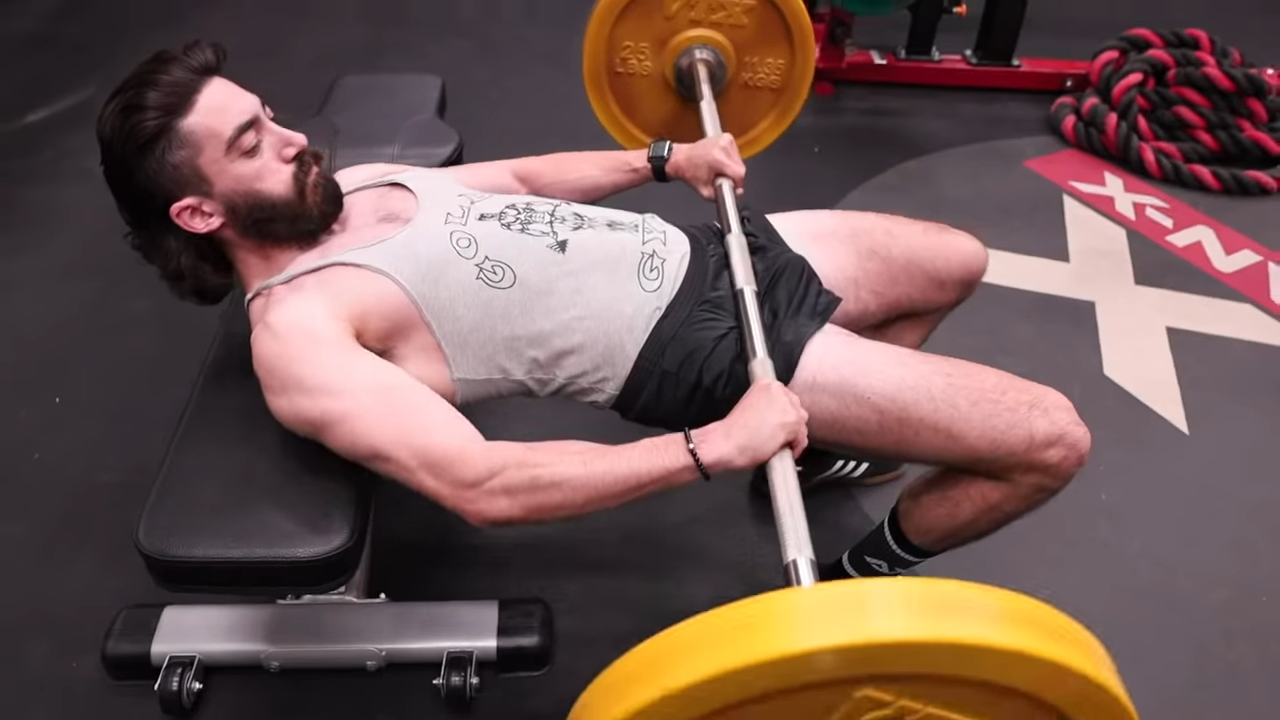
Next up is the Barbell Hip Thrust with an overhand grip. Perform three sets of eight to 10 reps.
Why not a Romanian Deadlift here?
I chose Barbell Hip Thrusts because this allows you to target the glutes without overtaxing yourself with deadlifting. I want you to be able to have the weight under control no matter how much you’re lifting. And I think the best way to do that is to avoid over-stressing those major leg muscles.
So, whether you’re following the synchronous or asynchronous split, this will give your lower back a little bit of relief.
DUMBBELL OR BARBELL REVERSE LUNGE


Perform two to three sets of 10 to 12 repetitions on each leg of the Dumbbell or Barbell Reverse Lunge with a staggered stance.
This is one of the best unilateral exercises for the lower body. The beauty of the step backwards is it takes some of the anterior force off the knee. And for people that are chronically dealing with knee pain, this gives them the chance to get the benefits of the lift without negative side effects.
DUMBBELL SINGLE LEG RDL / SLICK FLOOR BRIDGE CURL
This is your first RW, and that means “Rotate With.” These are two exercises that you should rotate every other time you do the workout.
The first time you’re going to do the Dumbbell Single Leg RDL.

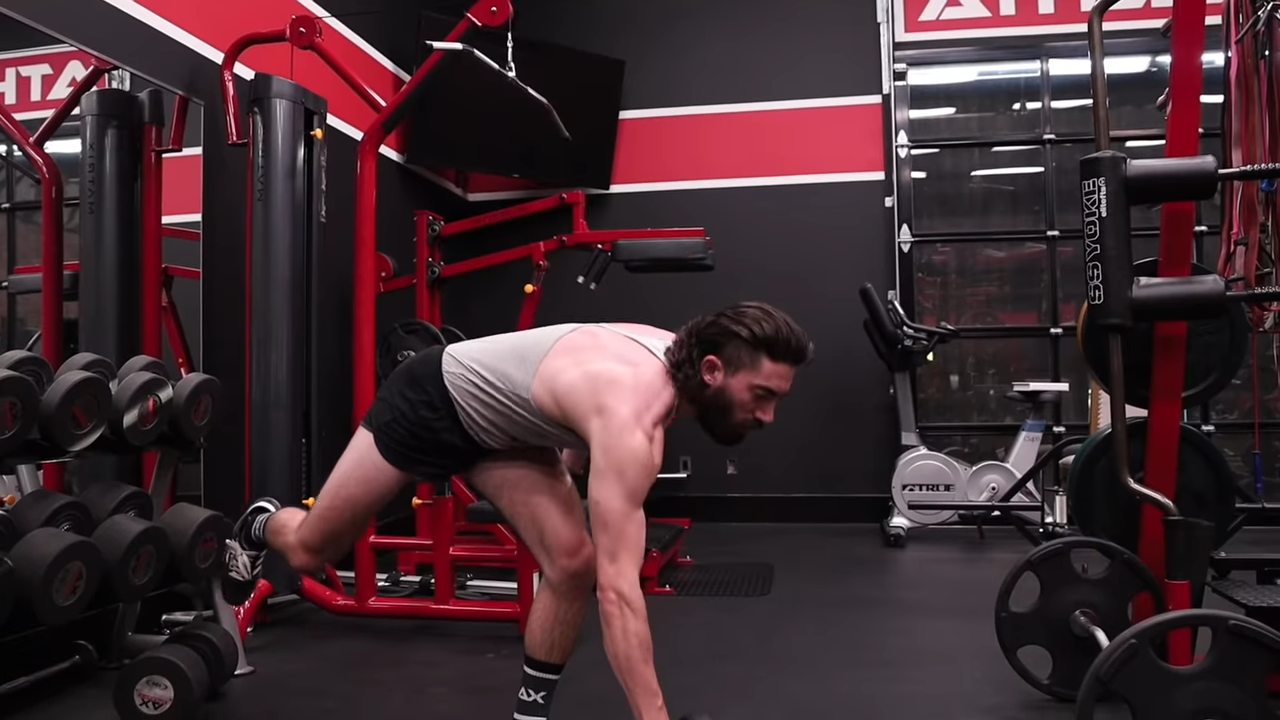
Perform two to three sets of 10 to 12 repetitions for each leg.
You’re going to rotate this during the next workout with the Slick Floor Bridge Curl.

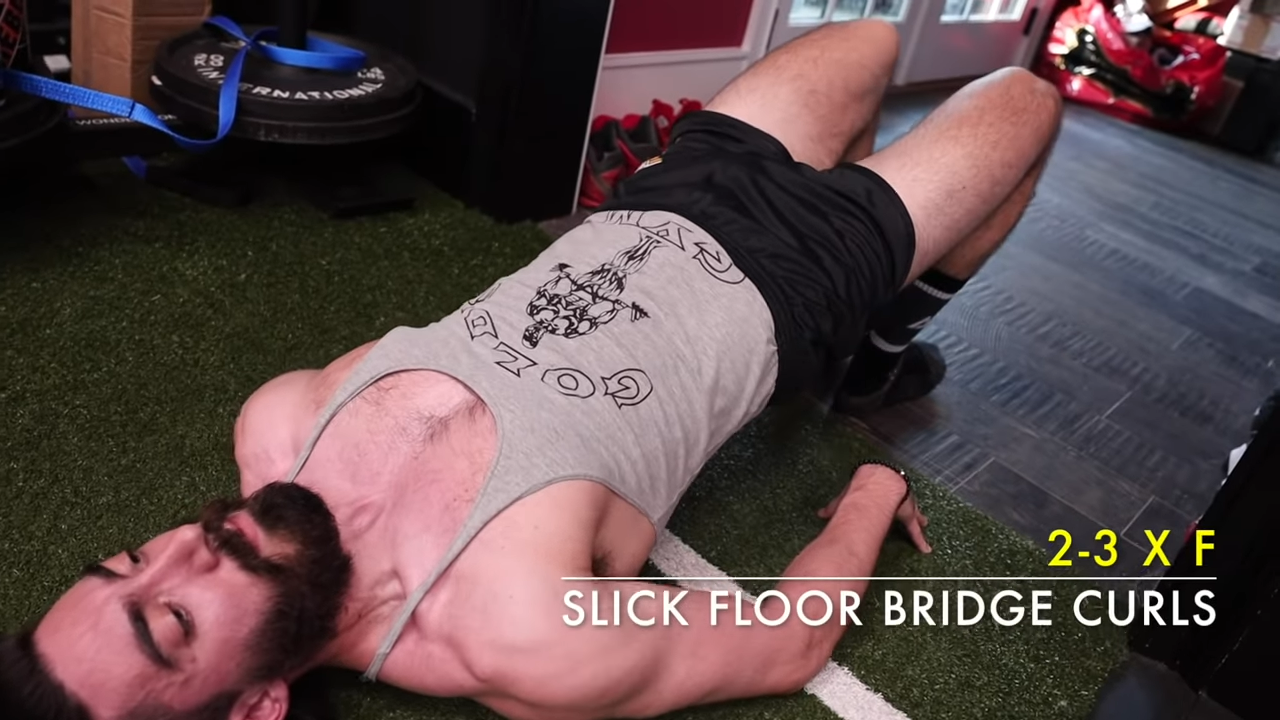
Perform two to three sets to failure. Don’t let the hips drop!
STANDING DUMBBELL CALF RAISE / SEATED DUMBBELL CALF RAISE
And that brings us to our last exercise for the calf muscles. We’re going to round out the perfect leg day workout with a little bit of calf work.
This is another one of those RW or Rotate With exercises. You’re going to do the Standing Dumbbell Calf Raise or the Seated Dumbbell Calf Raise. And the difference here is the position of the knee.
Perform three sets of 15 to 20 repetitions of the Standing Dumbbell Calf Raise.


And for the Seated Dumbbell Calf Raise, you’re also doing three sets of 15 to 20 reps.

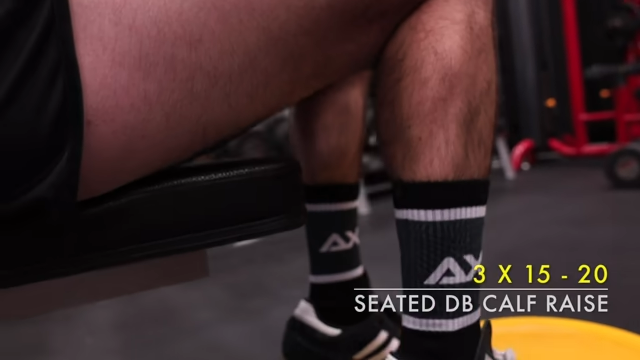
LEG WORKOUT SUMMARY
And there you have it, guys. A complete breakdown of why you should be doing a PPL split, along with an ENTIRE Push Pull Legs program.
Just like with every ATHLEAN-X workout, I want you to focus on quality, NOT quantity, especially if you’re doing the six-day splits I discussed above.
If you’re looking for a training program that will help you build muscle and incorporates all the best splits and techniques, you’ve come to the right place. See which of our ATHLEAN-X programs best fit your needs! Let me be your strength coach and personal trainer so that you can get your best results.

- One of the first pros of PPL is the flexibility of focus. This means that you can follow the split regardless of your training focus (e.g., strength gains, muscle mass, general fitness, or athletic training).
- The next pro of the PPL split is something called functional efficiency. Due to the compound nature of the exercises, you are providing a great opportunity for progressive overload.
- Another pro of the push pull legs split is built in muscle recovery factor.
- The next pro is that a 3-day PPL split allows for additional conditioning which lends itself well to those looking toward general fitness or even skill work for athletes.
- The first con of Push Pull Legs is the order that it is generally scheduled – with pull coming the day before legs. I generally don’t like having pull and legs back-to-back. An easy fix is to swap Push and Pull Days.
- The next con occurs if you decide to follow a 6-day synchronous split, which means Pull and Legs Days follow each other. A quick fix comes from the flexibility of the workouts where you can alter the nature of the compound movement on the second pull day.
- If you were to follow an asynchronous version of this PPL split, you don’t have to worry about doubling up on the pull and leg days which means that you wouldn’t have to worry about manipulating volume or exercise selection. The downside, however, is that there is an ever rotating off-day, which means that your schedule would need to be more fluid than it might be right now.
- The next potential con is that some might say that there are only 3 training days in a given week. Well, we’ve proven that wrong with the 6-day synchronous and asynchronous splits.
- Another objection might be that there are two days of upper-body workout and only one lower body workout routine. If you follow my recommendation of deadlifting on Pull Day, you are getting significant lower body activation.
- Finally, some say that with a PPL split it is harder to incorporate intensity techniques, but I will argue that it’s not, simply because you are afforded a good rest opportunity between each repeating workout.
PUSH PULL LEGS FAQ
A push pull leg split is a workout split in which you alternate training pull muscles on one training day, upper and lower body push muscles the next training day and leg muscles on the following training day to give each of these muscles a chance to recover before the next training session. There are several types of push pull leg splits including synchronous and asynchronous splits, and 6-day or 3-day schedules.
Push pull leg splits have many benefits for building muscle throughout the body instead of just a single muscle. They allow for sufficient recovery time and they are easy to modify to add in exercises or days for other training goals including conditioning. This flexibility and the predictable nature of a synchronous split complements athletic training because you can incorporate your sports training without conflicting with your weight training.
A 6-day push pull legs workout split schedule is ideal for giving each of the muscle groups adequate days of rest in between training sessions, while at the same time being able to work each area two times per week.
Push pull legs workout splits have many benefits including predictability of schedule and adequate recovery time between training sessions. They are also easy to modify to suit your needs which allows you to incorporate conditioning work or other athletic training. Push pull leg splits also allow muscles to work together that prefer to work together which creates efficiency that can give great results.
The push pull legs workout split is the best for beginner, intermediate or experienced lifters because there is so much flexibility and recovery time built into it.
The push pull legs workout split is ideal for bodybuilders or any fitness level because it allows you to train each muscle group two days per week while still allowing for adequate rest time between training sessions. It also gives you the flexibility to include accessory movements or other training types into your weekly routine. Push pull legs is a great strategy for muscle development.
Push pull legs training is very effective for building muscle and strength because it allows you to train each muscle group two days per week while still allowing for adequate rest time between training sessions. It also gives you the flexibility to add in other types of training to suit your goals.
REFERENCES

Jeff Cavaliere M.S.P.T, CSCS
Jeff Cavaliere is a Physical Therapist, Strength Coach and creator of the ATHLEAN-X Training Programs and ATHLEAN-Rx Supplements. He has a Masters in Physical Therapy (MSPT) and has worked as Head Physical Therapist for the New York Mets, as well as training many elite professional athletes in Major League Baseball, NFL, MMA and professional wrestling. His programs produce “next level” achievements in muscle size, strength and performance for professional athletes and anyone looking to build a muscular athletic physique.















